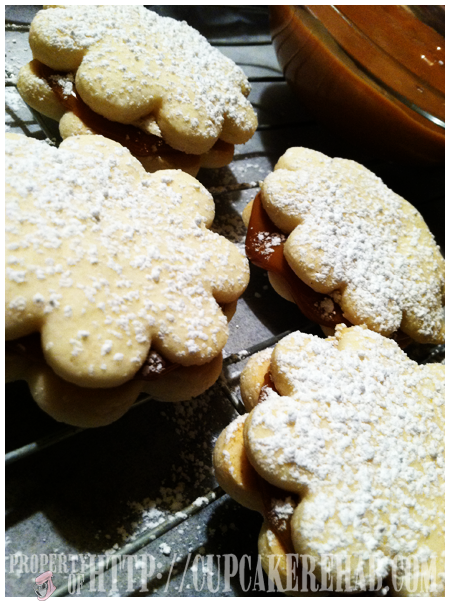Well Happy New Year, everyone. It’s 2012, we’re all another year older & the winter has officially dug in its heels. Its quite cold & blustery & the wind whistles like a Dickens’ inspired movie. So yeah- I’d say it’s wintertime. Apparently, it’s not going anywhere until the spring, so we just have to deal. Life should be enjoyed, as much as possible, despite (and maybe even because of) the miserably cold weather. And what better way to enjoy life than with cookies? This is another cookie recipe from The Cookiepedia by Stacy Adimando. Remember that book? I did a giveaway for it back in November. Pretty much as soon as I got it, I knew there would be four recipes I’d have to make immediately: the frosted maple pecan cookies (made those babies already), the pistachio cookies (still on the list), the pignoli cookies (I keep forgetting to buy almond paste so these are still on the list) and of course, the alfajores with dulce de leche. And those, my friends, are what this post is about.
I admit, I had no freakin’ idea what the hell an ‘alfajor’ was before this. But I’m not one to turn down making a delicious looking cookie. I don’t know how anyone could deny a cookie, let alone a shortbread-like cookie, let alone a shortbread-like cookie made into a sandwich with dulce de leche filling.

While they have origins in Moorish Spain, alfajores are especially popular in South America. They are simple shortbread sandwich cookies with a sweet filling of dulce de leche. Different doughs are used for the cookies depending on the country. Some use normal flour dough, while others add cornstarch or even cassava flour for a more delicate crumb.
– courtesy of whats4eats.com
Literally translated, dulce de leche means “sweet from milk”. It is prepared by slowly heating sweetened milk to create a product that derives its taste from caramelised sugar. It is a popular sweet in Latin America, where it is known under a variety of names. In Chile, Ecuador and Panama it is known as manjar. In Peru, Colombia and Venezuela it is referred to as manjar blanco or arequipe, depending on regional variations. In Mexico and Nicaragua is is commonly called cajeta. It is also found in Brazil, known by its Portuguese name doce de leite.
A French version, known as confiture de lait, is very similar to the spreadable forms of dulce de leche. A Norwegian version, Hamar-pålegg (“Hamar spread”), better known as HaPå, is a relatively thick and not so sweet commercial variant.
Yes. Yes, yes, yes. Shortbread & caramel sandwiches. That’s basically what I said: “What the what?!” Insane. Insane goodness. They really are. And very easy to put together, especially since you can use store-bought dulce de leche with absolutely no problem. I however, used a clever little method that’s a personal favorite of mine to make a caramel-like filling using a boiled can of condensed milk. Mmm. This particular cookie recipe uses flour & cornstarch to create the perfect soft crumbly-ness that goes excellently with the thick caramel heavenly-ness in between it.



…
ALFAJORES WITH DULCE DE LECHE (from The Cookiepedia)
Ingredients:
- 6 tablespoons unsalted butter, room temperature
- ½ cup sugar
- 1 cup all-purpose flour
- ¾ cup cornstarch
- 1 teaspoon baking powder
- ¼ teaspoon salt
- 1 egg
- 1 egg yolk
- 1 teaspoon pure vanilla extract
- powdered sugar, for dusting
- Dulce de leche, for filling
Directions:
- Cream the butter & sugar together for a minute or two, until they look light & fluffy.
- In the meantime, sift the flour, cornstarch, baking powder & salt in a bowl & set aside.
- Add the egg & egg yolk one at a time to the butter mixture, mixing after each addition. Add the vanilla and mix briefly. Add the flour mixture & mix until the dough just starts to come together.
- Working quickly, turn out the dough and use a little heat from your hands to make it a solid ball. Pull out a large piece of plastic wrap, then flatten the dough on top of it to make a disk. Double wrap it and refrigerate for 1 hour until firm.
- Preheat oven to 325° F. Line several cookie sheets with parchment paper or Silpats®. Roll out the dough to ¼”-inch thick on a lightly floured surface. Rotate the dough between rolls to make sure it’s not sticking. Using a 2-inch fluted or round cutter, cut out cookies & carefully place them on the cookie sheets, placing them about 1 inch apart.
- Chill the sheets again for 15 to 20 minutes, until the dough is once again very firm. Then bake for 8 to 10 minutes, until the tops of the cookies have just firmed & the bottoms are just starting to color slightly. Cool on wire racks before assembling the sandwiches.
- Drop, pipe, or spread a teaspoon of dulce de leche into the center of each cookie, then top with another. Sift powdered sugar over the assembled sandwiches.



…
These are perfect winter cookies. Filling, and sweet but not too sweet. Comforting. And like I said… easy. I know this time of year everyone is sort of taking a deep breath after the craziness of the holidays have ended. But these are definitely worth the little effort they require. Plus, who doesn’t like an excuse to have the oven on this time of year?
Okay so, on to the dulce de leche. The author recommends using an artisanal or high-end brand, herself. Like I said, I used a caramel-like substance made from boiling a can of condensed milk & it was amazing. Not everyone is as ballsy as I am, and that can be a dangerous method. So naturally use whatever your comfortable with, and whatever brand you like. Of course, you can also make your own dulce de leche (she gives a recipe- but you’ll have to buy the book for that one!). Let me also state that they’d work amazingly well with a jam or chocolate filling, as well as a chocolate coating.
And of course, the packaging has to match the spectacular nature of what it holds, right?
 …
…
My new favorite way of packaging cookies to give away is in jars. I started doing it with the first cookie recipe I made from this book, and it got such rave reviews I kept doing it. For Christmas, I gave tons of cookies, brownies & pieces of homemade fudge as gifts & most were in either tins or jars like the one above. This time, I dressed up the jar with an authentic vintage Air Mail envelope & some soft twine. I thought the name of the cookies was exotic enough that the envelope would be an appropriate label. These jars can be found in a lot of places, especially in plastic… the glass version like mine is a bit more costly usually, however occasionally you can get them for a good price. But you don’t have to just use flip-top jars. Even using quart or pint Ball® jars is an excellent idea- fill it up with cookies, put the lid on, cover the lid in a square of pretty fabric (or cupcake liner!), screw the band on, then tie on a label with some string or some ribbon & you’re good to go. They’re also great for giving chocolate dipped pretzel sticks or candied citrus peel because those items can be delicate.
So there you have it. Alfajores. Who’da thunk it?
…

 I'm Marilla. A 30-something artist, hobby baker, home canning enthusiast, gardener, DIY-er, wife, mommy of a baby boy and dog mom (to another baby boy) from New York.
I'm Marilla. A 30-something artist, hobby baker, home canning enthusiast, gardener, DIY-er, wife, mommy of a baby boy and dog mom (to another baby boy) from New York. 








Hello, the whole thing is going nicely here and ofcourse every one
is sharing data, that’s truly good, keep up
writing.
I got this website from my friend who shared with
me regarding this website and now this time I
am browsing this website and reading very informative content at this time.
Greetings from Idaho! I’m bored to death at work
so I decided to check out your site on my iphone during lunch break.
I really like the info you present here and can’t wait to take a look when I get
home. I’m amazed at how fast your blog loaded on my phone ..
I’m not even using WIFI, just 3G .. Anyhow, awesome site!
I’m not that much of a internet reader to be honest but your
sites really nice, keep it up! I’ll go ahead and bookmark your website to come back in the future.
All the best
Ahaa, its good conversation about this article at this place at this blog,
I have read all that, so now me also commenting here.
Hello would you mind letting me know which web host you’re utilizing?
I’ve loaded your blog in 3 completely different internet browsers and I must
say this blog loads a lot quicker then most.
Can you recommend a good hosting provider at a reasonable price?
Thank you, I appreciate it!
Hello, everything is going nicely here and ofcourse every one is sharing facts,
that’s really fine, keep up writing.
The Zune concentrates on being a Portable Media Player. Not a web browser. Not a game machine. Maybe in the future it’ll do even better in those areas, but for now it’s a fantastic way to organize and listen to your music and videos, and is without peer in that regard. The iPod’s strengths are its web browsing and apps. If those sound more compelling, perhaps it is your best choice.
Hello, just wanted to mention, I liked this blog post.
It was helpful. Keep on posting!
I’ll gear this review to 2 types of people: current Zune owners who are considering an upgrade, and people trying to decide between a Zune and an iPod. (There are other players worth considering out there, like the Sony Walkman X, but I hope this gives you enough info to make an informed decision of the Zune vs players other than the iPod line as well.)
Outstanding story there. What occurred after? Good
luck!
As soon as I observed this internet site I went on reddit to share some of the love
with them.
I visited many sites but the audio quality for audio songs existing at this site is genuinely wonderful.
Ahaa, its pleasant conversation regarding this article here at this weblog,
I have read all that, so at this time me also commenting at this place.
I always emailed this weblog post page to all my contacts,
since if like to read it then my links will too.
Remarkable! Its actually amazing paragraph, I have
got much clear idea concerning from this article.
When I initially commented I clicked the “Notify me when new comments are added” checkbox and now each time a comment is added I get several
emails with the same comment. Is there any way you can remove me
from that service? Thank you!
you are really a excellent webmaster. The website loading velocity is amazing.
It seems that you’re doing any distinctive trick. Also,
The contents are masterwork. you have performed a excellent task in this subject!